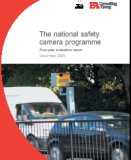12/15/2005
UK: Government Study Admits Camera Benefits OverstatedNew UK government speed camera study admits at least 80 percent of claimed serious accident reduction could be achieved without the device.

The long-awaited UK Department for Transport study of the effects of speed camera enforcement released today suggests, in an appendix at the end of the report, that the device's safety effect may be overstated by a factor of five. The report's executive summary first proclaims that the national speed camera policy has achieved a 2.2 MPH reduction in average speeds at camera sites and a 42 percent reduction in the number of people killed or seriously injured.
These figures, however, come with brand new disclaimers: "This (figure) is subject to some reduction due to regression-to-mean (RTM)... which will exaggerate accident savings estimated in the main analysis." Tucked away at the very end of the report is the explanation of the disclaimer along with the correction of the main analysis:
"Whenever site selection is based on particularly high numbers of observed collisions in a particular period of time, the sites identified will tend to be those with more collisions than expected during the period of observation. Such locations will then tend to have fewer collisions in a subsequent time period (with or without a camera) simply because the collision count in the first time period was abnormally high. This is the RTM effect. If RTM effects are not allowed for there is a danger that the effectiveness of cameras will be over-estimated." (Page 143)
The report accounts for these errors by examining the sites with the most available traffic data and comparing them to similar sites that do not have cameras. Overall, the camera sites saw a 54.5 percent drop in fatal and serious collisions. However, an adjustment for regression to the mean errors and long-term accident trends, shows the same site would have experienced a 44.1 percent drop in those collisions had the speed cameras never been present. The report goes further to suggest that even the remaining effect attributed to the cameras may in fact be due to drivers avoiding monitored roads.
"Previous research... however, suggests that part of the reduction in collisions attributable to the cameras may be due to diversion of traffic away from routes with cameras," the report states. "There is thus a possibility that some of the collision reduction attributable to cameras may be compensated for by an increase in collisions on diversionary routes." (Page 154-5)
In releasing the report, Transport Secretary Alistair Darling announced a possible slowdown in the deployment rate of cameras -- the nation currently has around 6000 fixed and mobile ticketing devices. A new regulation would allow speed camera profits to be directed to "road safety" measures other than more speed cameras.
"The Department for Transport's move away from speed cameras is a shameful and cowardly attempt to pretend that their policy has been working and it's clearly time to move on," said Paul Smith of the Safe Speed road safety campaign. "Realising the gross error, DfT now seeks to move quietly away from speed cameras and the disastrous speed camera funding scheme."
The full report is available in a 1mb PDF file at the source link below.


